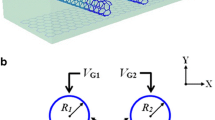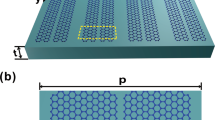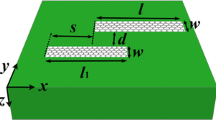Abstract
A numerical and theoretical study is presented on the realization of tunable plasmon-induced transparency (PIT) phenomenon in the three-dimensional patterned graphene nanostrips. The simulation results reveal that the PIT effect is generated due to the excitation of dark mode which can be considered a dipole. The three-level plasmonic system is employed to explain the physical mechanism of the PIT effect. Different from previous reported form (dipole-quadrupole coupling), the proposed is attributed to the dipole-dipole coupling. The PIT effect can be tuned by changing the coupling length between bright and dark mode as well as the Fermi energy of graphene. Our studies provide guidance for fabricating ultra-compact devices in practical application.




Similar content being viewed by others
References
Ates C, Sevincli S, Pohl T (2011) Electromagnetically induced transparency in strongly interacting Rydberg gases. Phys Rev A 83:041802
Kurter C, Tassin P, Zhang L, Koschny T, Zhuravel AP, Ustinov AV, Soukoulis CM (2011) Classical analogue of electromagnetically induced transparency with a metal-superconductor hybrid metamaterial. Phys Rev Lett 107:043901
Rohlsberger R, Wille H, Schlage K, Sahoo B (2012) Electromagnetically induced transparency with resonant nuclei in a cavity. Nature 482:199–203
Liu N, Weiss T, Mesch M, Langguth L, Eigenthaler U, Hirscher M, Sonnichsen C, Giessen H (2010) Planar metamaterial analogue of electromagnetically induced transparency for plasmonic sensing. Nano Lett 10:1103–1107
Dong ZG, Liu H, Cao JX, Li T, Wang SM, Zhu SN, Zhang X (2010) Enhanced sensing performance by the plasmonic analog of electromagnetically induced transparency in active metamaterials. Appl Phys Lett 97:114101
Phillips D, Fleischhauer A, Mair A, Walsworth R, Lukin M (2001) Storage of light in atomic vapor. Phys Rev Lett 86:783–786
Khanikaev AB, Mousavi SH, Wu C, Dabidian N, Alici KB, Shvets G (2012) Electromagnetically induced polarization conversion. Opt Commun 285:3423–3427
Chen J, Wang P, Chen C, Lu Y, Ming H, Zhan Q (2011) Plasmonic EIT-like switching in bright-dark-bright plasmon resonators. Opt Express 19:5970–5978
Schmidt H, Ram RJ (2000) All-optical wavelength converter and switch based on electromagnetically induced transparency. Appl Phys Lett 76:3173
He JN, Wang JQ, Ding P, F CZ, Arnaut LR, Liang EJ (2015) Optical switching based on polarization tunable plasmon-induced transparency in Disk/Rod hybrid metasurfaces. Plasmonics. doi:10.1007/s11468-015-9911-8, online
Yun B, Hu G, Cong J, Cui Y (2014) Plasmon induced transparency in metal insulator metal waveguide by a stub coupled with F-P resonator. Mater Res Express 1:036201
Deng ZL, Dong JW (2013) Lasing in plasmon-induced transparency nanocavity. Opt Express 21:20291–20302
Wang L, Gu Y, Chen H, Zhang JY, Cui Y, Gerardot BD, Gong Q (2013) Polarized linewidth-controllable double-trapping electromagnetically induced transparency spectra in a resonant plasmon nanocavity. Sci Rep 3:2879
Liu ZZ, Xiao JJ, Zhang Q, Zhang XM, Tao KY (2015) Collective dark states controlled transmission in plasmonic slot waveguide with a stub coupled to a cavity dimer. Plasmonics. doi:10.1007/s11468-015-9901-x, online
Cao GT, Li HJ, Deng Y, Zhan SP, He ZH, Li BX (2014) Plasmon-induced transparency in a single multimode stub resonator. Opt Express 22:25215
Kekatpure RD, Barnard ES, Cai W, Brongersma ML (2010) Phase-coupled plasmon-induced transparency. Phys Rev Lett 104:243902
Wang L, Cai W, Luo WW, Ma ZH, Du CL, Zhang XZ, Xu JJ (2014) Mid-infrared plasmon induced transparency in heterogeneous graphene ribbon pairs. Opt Express 22:32450
Zhang S, Genov DA, Wang Y, Liu M, Zhang X (2008) Plasmon-induced transparency in metamaterials. Phys Rev Lett 101:047401
Zhang Z, Zhang L, Li H, Chen H (2014) Plasmon induced transparency in a surface plasmon polariton waveguide with a comb line slot and rectangle cavity. Appl Phys Lett 104:231114
Cheng H, Chen SQ, Yu P, Duan XY, Xie BY, Tian JG (2013) Dynamically tunable plasmonically induced transparency in periodically patterned graphene nanostrips. Appl Phys Lett 103:203112
Liu H, Li B, Zheng L, Xu C, Zhang G, Wu X, Xiang N (2013) Multispectral plasmon induced transparency in triangle and nanorod(s) hybrid nanostructures. Opt Lett 38:977–979
Christensen J, Manjavacas A, Thongrattanasiri S, Koppens FH, de Abajo FJG (2012) Graphene plasmon waveguiding and hybridization in individual and paired nanoribbons. ACS Nano 6:431–440
Geim AK, Novoselov KS (2007) The rise of graphene. Nat Mater 6:183–191
Thongrattanasiri S, Manjavacas A, Javier Garc F (2012) Quantum finite-size effects in graphene plasmons. ACS Nano 6:1766–1775
Koppens FHL, Chang DE, Garca J, de Abajob F (2011) Graphene plasmonics: a platform for strong light-matter interactions. Nano Lett 11:3370–3377
Novoselov KS (2013) Electric field effect in atomically thin carbon films. Science 306:666
Novoselov KS, Geim AK, Morozov SV, Jiang D, Katsnelson MI, Grigorieva IV, Dubonos SV, Firsov AA (2005) Two-dimensional gas of massless Dirac fermions in graphene. Nature 438:197–200
He Z, Li HJ, Zhan SP, Cao GT, Li BX (2014) Combined theoretical analysis for plasmon induced transparency in waveguide systems. Opt Lett 39:5543–5546
Correas-Serrano D, Gomez Diaz JS, Perruisseau-Carrier J, Alvarez-Melcon A (2013) Graphene based plasmonic tunable low pass filters in the THz band. IEEE Trans Nanotechnol 13:1145–1153
Rodrigo D, Limaj O, Janner D, Etezadi D, de Abajo FJG, Pruneri V, Altug H (2015) Mid-infrared plasmonic biosensing with graphene. Science 349:165–168
Acknowledgments
This work was supported by the National Natural Science Foundation of China (Grant Nos, 61176116, 11074069) and the Specialized Research Fund for the Doctoral Program of Higher Education of China (Grant No. 20120161130003).
Author information
Authors and Affiliations
Corresponding author
Rights and permissions
About this article
Cite this article
Shang, Xj., Zhai, X., Li, Xf. et al. Realization of Graphene-Based Tunable Plasmon-Induced Transparency by the Dipole-Dipole Coupling. Plasmonics 11, 419–423 (2016). https://doi.org/10.1007/s11468-015-0069-1
Received:
Accepted:
Published:
Issue Date:
DOI: https://doi.org/10.1007/s11468-015-0069-1




